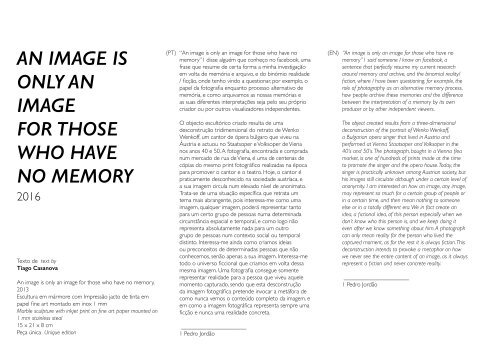PORTFÓLIO TIAGO CASANOVA
You also want an ePaper? Increase the reach of your titles
YUMPU automatically turns print PDFs into web optimized ePapers that Google loves.
AN IMAGE IS<br />
ONLY AN<br />
IMAGE<br />
FOR THOSE<br />
WHO HAVE<br />
NO MEMORY<br />
2016<br />
Texto de text by<br />
Tiago Casanova<br />
An image is only an image for those who have no memory,<br />
2013<br />
Escultura em mármore com Impressão jacto de tinta em<br />
papel fine art montado em inox 1 mm<br />
Marble sculpture with inkjet print on fine art paper mounted on<br />
1 mm stainless steal<br />
15 x 21 x 8 cm<br />
Peça única Unique edition<br />
(PT)<br />
“An image is only an image for those who have no<br />
memory”1 disse alguém que conheço no facebook, uma<br />
frase que resume de certa forma a minha investigação<br />
em volta de memória e arquivo, e do binómio realidade<br />
/ ficção, onde tenho vindo a questionar, por exemplo, o<br />
papel da fotografia enquanto processo alternativo de<br />
memória, e como arquivamos as nossas memórias e<br />
as suas diferentes interpretações seja pelo seu próprio<br />
criador ou por outros visualizadores independentes.<br />
O objecto escultórico criado resulta de uma<br />
desconstrução tridimensional do retrato de Wenko<br />
Wenkoff, um cantor de ópera búlgaro que viveu na<br />
Áustria e actuou no Staatsoper e Volksoper de Viena<br />
nos anos 40 e 50. A fotografia, encontrada e comprada<br />
num mercado de rua de Viena, é uma de centenas de<br />
cópias do mesmo print fotográfico realizadas na época<br />
para promover o cantor e o teatro. Hoje, o cantor é<br />
praticamente desconhecido na sociedade austríaca, e<br />
a sua imagem circula num elevado nível de anonimato.<br />
Trata-se de uma situação específica que retrata um<br />
tema mais abrangente, pois interessa-me como uma<br />
imagem, qualquer imagem, poderá representar tanto<br />
para um certo grupo de pessoas numa determinada<br />
circunstância espacial e temporal, e como logo não<br />
representa absolutamente nada para um outro<br />
grupo de pessoas num contexto social ou temporal<br />
distinto. Interessa-me ainda como criamos ideias<br />
ou preconceitos de determinadas pessoas que não<br />
conhecemos, senão apenas a sua imagem. Interessa-me<br />
todo o universo ficcional que criamos em volta dessa<br />
mesma imagem. Uma fotografia consegue somente<br />
representar realidade para a pessoa que viveu aquele<br />
momento capturado, sendo que esta desconstrução<br />
da imagem fotográfica pretende invocar a metáfora de<br />
como nunca vemos o conteúdo completo da imagem, e<br />
em como a imagem fotográfica representa sempre uma<br />
ficção e nunca uma realidade concreta.<br />
______________________<br />
1 Pedro Jordão<br />
(EN)<br />
“An image is only an image for those who have no<br />
memory”1 said someone I know on facebook, a<br />
sentence that perfectly resume my current research<br />
around memory and archive, and the binomial reality/<br />
fiction, where I have been questioning, for example, the<br />
role of photography as an alternative memory process,<br />
how people archive these memories and the difference<br />
between the interpretation of a memory by its own<br />
producer or by other independent viewers.<br />
The object created results from a three-dimensional<br />
deconstruction of the portrait of Wenko Wenkoff,<br />
a Bulgarian opera singer that lived in Austria and<br />
performed at Vienna Staatsoper and Volksoper in the<br />
40’s and 50’s. The photograph, bought in a Vienna flea<br />
market, is one of hundreds of prints made at the time<br />
to promote the singer and the opera house. Today, the<br />
singer is practically unknown among Austrian society, but<br />
his images still circulate although under a certain level of<br />
anonymity. I am interested on how an image, any image,<br />
may represent so much for a certain group of people or<br />
in a certain time, and then mean nothing to someone<br />
else or in a totally different era. We in fact create an<br />
idea, a fictional idea, of this person especially when we<br />
don’t know who this person is, and we keep doing it<br />
even after we know something about him. A photograph<br />
can only mean reality for the person who lived the<br />
captured moment, as for the rest it is always fiction. This<br />
deconstruction intends to provoke a metaphor on how<br />
we never see the entire content of an image, as it always<br />
represent a fiction and never concrete reality.<br />
______________________<br />
1 Pedro Jordão


















